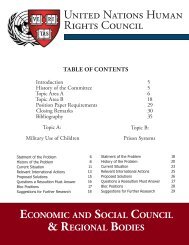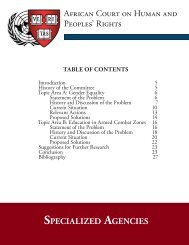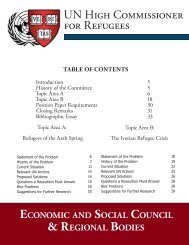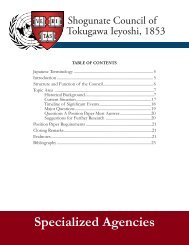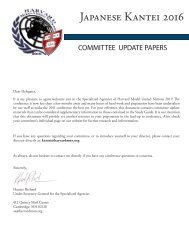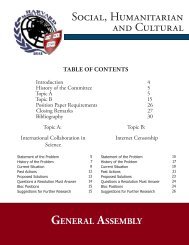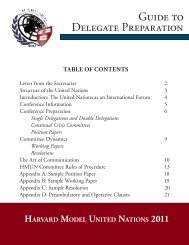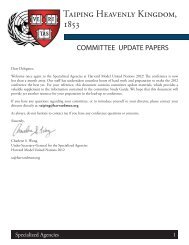World Trade Organization - Harvard Model United Nations
World Trade Organization - Harvard Model United Nations
World Trade Organization - Harvard Model United Nations
Create successful ePaper yourself
Turn your PDF publications into a flip-book with our unique Google optimized e-Paper software.
environmental goals. These measures, as explained<br />
below, are primarily used to control trade, where trade<br />
is perceived to contribute directly to environmental<br />
damage, and to add incentive to adhere to the MEA by<br />
imposing trade penalties. Because WTO members must<br />
observe the most-favored nation and national treatment<br />
principles and eliminate “quantitative restrictions,”<br />
they are put in a difficult situation when faced with an<br />
environmental agreement that says parties can use trade<br />
restrictions against some countries (non-parties) but not<br />
against others (parties). According to environmental<br />
principles, they should follow the MEAs and penalize<br />
non-parties should they act in a manner harmful to the<br />
environment. According to trade principles, they are<br />
not following international trade rules outlined by the<br />
WTO. One example of this is the previously mentioned<br />
US-Mexico tuna dolphin example. The GATT panel<br />
ruled strictly based on the conditions of the trade treaties,<br />
without acknowledging or referencing MEAs. 69<br />
In recent years, steps have been taken to resolve WTO<br />
and MEA conflicts in other ways. Negotiators and new<br />
agreements now stress “mutual supportiveness” between<br />
WTO rules and MEAs rather than the old principle of<br />
supremacy of one principle. One such example is the<br />
Cartagena Protocol on Biosafety. In the preamble to<br />
the Protocol, there are three paragraphs that state the<br />
principle that “neither trade law nor the Protocol has a<br />
hierarchical position above the other, and, where there<br />
is overlap, the interpretation of each should be done<br />
in a manner striving to find consistency between both.”<br />
Another approach to promote mutual supportiveness is to<br />
implement MEAs in trade laws. In NAFTA, for example,<br />
there is a provision specifying under which conditions<br />
certain MEAs will prevail over NAFTA trade rules. 70<br />
<strong>Trade</strong>-related provisions<br />
One concern nations often have is how to balance<br />
trade law obligations (determined by WTO laws) with<br />
environmental obligations in MEAs. A way to reconcile<br />
the two is through trade-related provisions in MEAs.<br />
Although they are uncommon in MEAs, they have<br />
important effects on trade flows.<br />
Firstly, trade-related provisions in MEAs provide fairer<br />
regulatory frameworks. Participants in a market must be<br />
confident that all comparable parties are following the<br />
same regulatory constraints. Some constraints reflect<br />
economic and social choices of consumers while others<br />
reflect urgent environmental imperatives that must be<br />
respected above all else. <strong>Trade</strong>-related provisions allow<br />
General Assembly<br />
<strong>World</strong> <strong>Trade</strong> <strong>Organization</strong><br />
participants to see under which cases which constraints<br />
are mandatory for all members and which are viewed as<br />
optional. 71<br />
Another reason why such provisions are necessary is<br />
their ability to control markets. Some goods have high<br />
demand but meeting that demand could deplete the<br />
resources from which they’re made. The environmental<br />
opportunity cost of these goods may not be reflected in<br />
the market prices of those goods and thus market forces<br />
can’t prevent the resources from being depleted. In these<br />
circumstances, only an international structure of market<br />
control can promote conservation and protection. A key<br />
example of this is CITES, which protects certain species<br />
from the market forces and trade. 72<br />
While trade-related provisions help promote fairer<br />
competition and better protection of the environment,<br />
they also ensure compliance to environmental<br />
agreements. For example, the Montreal Protocol bans<br />
trade with non-parties in ozone-depleting substance.<br />
Because parties under the Protocol are limited in their<br />
production of ozone-depleting substances, they might<br />
try to take advantage by importing these substances<br />
The Montreal Protocol is an international treaty designed to protect<br />
the ozone layer by phasing out the production of numerous substances<br />
believed to be responsible for ozone depletion. Pictured above is the<br />
largest Antarctic ozone hole recorded as of September 2006.<br />
from countries not under the Protocol (non-parties).<br />
This trade-related provision in the Montreal Protocol<br />
ensures that the effectiveness and original purpose of the<br />
19





